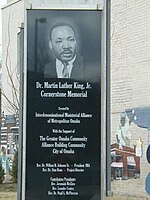North 24th Street
| South end | Dodge Street 41°15′35″N 95°56′49″W / 41.25972°N 95.94694°W |
|---|---|
| North end | Read Street 41°19′24″N 95°56′49″W / 41.32333°N 95.94694°W |
| Part of a series on |
| African Americans in Omaha |
|---|
|
North 24th Street is a two-way street that runs south–north in the
History

North 24th Street first became prominent as a center of

In the aftermath of the
July 4, 1966, marked the first of several
On June 24, 1969, an African-American teenager named
The business district along North 24th Street has not recovered since the riots; however, new investments by the City of Omaha have shown "promising returns" since 2000.[14]
Neighborhoods

North 24th Street begins at
Revitalization
In 2006, the
The City of Omaha is supporting this effort with the North 24th Street Historic Jazz District Project, focusing on the street between Ohio and Cuming Street. Funded by nearly $2 million in city and federal grants, the total estimated cost of the project is $3.5 million to $4.5 million.[3][17]
Notable locations

Several important
The Fair Deal Cafe, once known as Omaha's "Black City Hall", is being revitalized, as is the city's first African American banking institution, Carver Savings and Loan Association. Both sit along North 24th. Love’s Jazz and Art Center, named in honor of North Omaha native Preston Love, is located at 2510 North 24th Street.[19] The Native Omaha Club is located at 3819 North 24th Street.[20] The Dr. Martin Luther King Jr. Cornerstone Memorial, installed in 2006, is located at the intersection of North 24th and Lake Streets. The Dreamland Plaza, installed in 2004, is a tribute to the Dreamland Ballroom and is located at North 24th and Erskine Streets.[21] The bi-annual Native Omaha Days parade has been held along North 24th Street since the mid-1970s.
| Notable locations along North 24th Street - alphabetical order | |||||
|---|---|---|---|---|---|
| Location | Name | Built | Notes | ||
| 3105 North 24th Street | Calvin Memorial Presbyterian Church | 1910 | |||
| 2221 North 24th Street | Jewell Building | 1923 | |||
| 3612 North 24th Street | Redick Mansion | 1875 | Moved from Omaha in 1907, it was the first home of Omaha University .
| ||
| 1311 North 24th Street | Paul Street School | 1892 | it was replaced with Kellom Elementary School in 1952.[18] | ||
| 2216 North 24th Street | Omaha Star building | 1923 | It was a mortuary and social hall before becoming home to the historic Omaha Star. | ||
| 2319 Ogden Street | Pearl Memorial United Methodist Church | 1926 | |||
| 2412 Ames Avenue | Druid Hall | 1915 | Home of Nebraska's last Prince Hall Masons chapter.
| ||
| 2118 North 24th Street | Fair Deal Cafe | Once known as Omaha's "Black City Hall" | |||
| 2416 Lake Street | Carver Savings and Loan Association | 1944 | The city's first African American banking institution. | ||
| 2510 North 24th Street | Love’s Jazz and Art Center
|
Named in honor of North Omaha native Preston Love.[19] | |||
| 3819 North 24th Street | Native Omaha Club | [20] | |||
| North 24th and Lake Street | Dr. Martin Luther King Jr. Cornerstone Memorial | 2006 | [21] | ||
See also
References
- ^ "A history of North 24th Street," Adam Fletcher Sasse, NorthOmahaHistory.com. Retrieved January 19, 2023.
- ^ "A Street of Dreams," Nebraska Public Media. Air Date, 08/01/1994. Retrieved April 8, 2024.
- ^ a b (2007) "Jazz District". DesignLine. OmahaByDesign. Retrieved 2008-05-25.
- ^ "Services", Love’s Jazz and Art Center. Retrieved 2008-05-25.
- ^ Landmarks Heritage Preservation Commission. (1980) A Comprehensive Program for Historic Preservation in Omaha. City of Omaha. p 54.
- ^ a b The Street of Dreams.
- ^ Roosenfelt, D.S. (1995) Tell ME a Riddle: Tillie Olsen. Rutgers University Press. p 118.
- ^ Savage, B.L. and Shull, C.D. (eds) (1994) African American Historic Places. John Wiley and Sons. p 332.
- ^ Luebtke, F.C. (2005) Nebraska: An Illustrated History. University of Nebraska Press. p. 334.
- ^ Levine, B.J. (2004) Resolving Racial Conflict: The Community Relations Service and Civil Rights. University of Missouri Press. p 105.
- ^ Olson, J.C. and Naugle, R.C. (1997) History of Nebraska. University of Nebraska Press. p 371.
- ^ Luebtke, F.C. (2005) Nebraska: An Illustrated History. University of Nebraska Press. p. 372.
- ^ "Firebombings in Omaha", the New York Times. June 26, 1969. Retrieved 2008-04-21.
- ^ Larsen, Cotrell, Daub and Daub. (2007) Upstream Metropolis: An urban biography of Omaha and Council Bluffs. University of Nebraska Press. p 414.
- ^ "North Omaha Development Project Description". Omaha Chamber of Commerce. p 1. Retrieved 2007-08-28.
- ^ Kotok, C.D. "Big plans in store for north Omaha" Archived 2012-09-12 at archive.today, Omaha World-Herald. October 3, 2007. Retrieved 2008-05-25.
- ^ (2007) Omaha Catalogue of Urban Design Philanthropy. Omaha Community Foundation. Retrieved 2008-05-25.
- ^ a b "Kellom Elementary School: Our History" Archived 2007-12-20 at the Wayback Machine. Omaha Public Schools. Retrieved 2008-05-25.
- ^ a b Loves Jazz and Arts Center Archived 2007-03-28 at the Wayback Machine. Retrieved 2008-05-25.
- ^ a b Native Omaha Days Home Archived 2011-08-23 at the Wayback Machine. Retrieved 2008-05-25.
- ^ a b "Jazz and all that," Archived 2007-09-28 at the Wayback Machine OmahaByDesign.com. Retrieved 2008-05-25.
External links
- "A History of North 24th Street" by Adam Fletcher Sasse for NorthOmahaHistory.com
- Modern rendering of planned rejuvenation of North 24th and Cuming Streets
- Historic postcard of the intersection of North 24th and Grant after the 1913 tornado
- Historic postcard of the intersection of North 24th and Lake after the 1913 tornado
- Historic postcard of the intersection of North 24th and Ohio after the 1913 tornado
